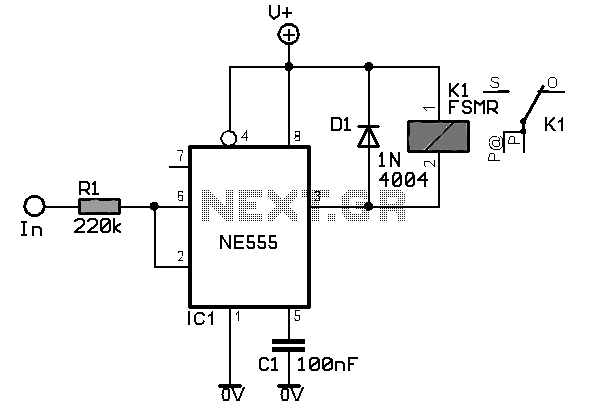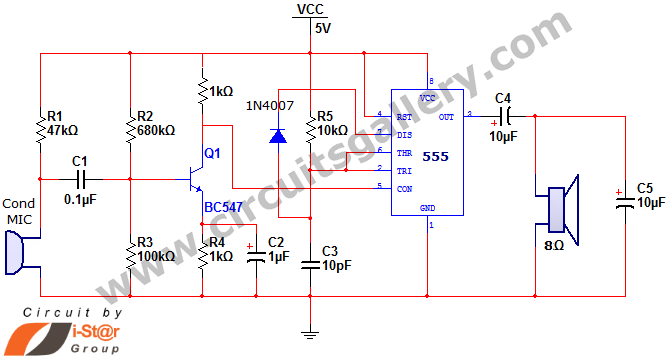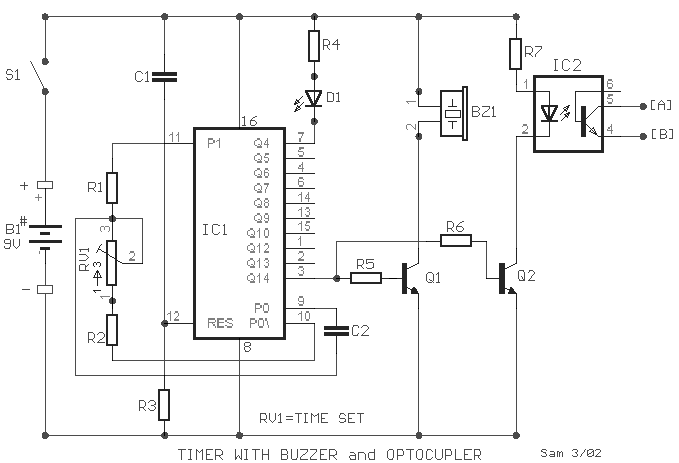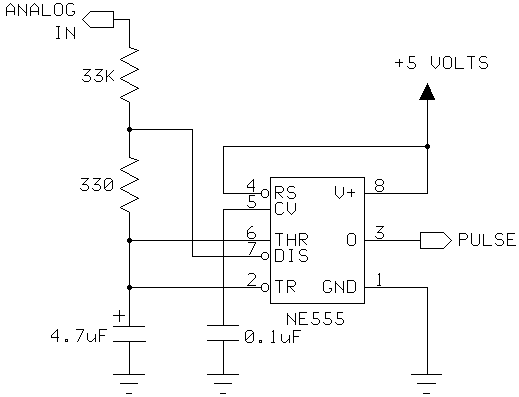
24 Hour Timer
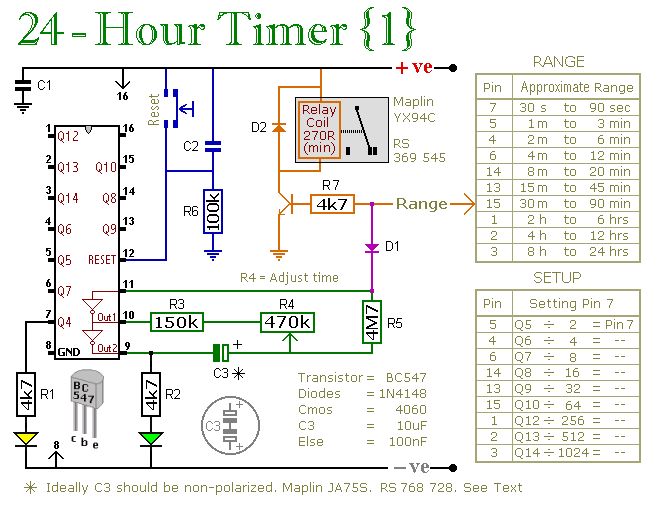
These two circuits are multi-range timers that offer periods of up to 24 hours and beyond. Both circuits are fundamentally similar, with the key distinction being that Version 1 energizes the relay when the time expires, while Version 2 de-energizes it. Version 1 consumes less power during operation, whereas Version 2 is designed to use less power once the timer has completed its cycle. Choose the version that best fits the specific application requirements. The CMOS 4060 functions as a 14-bit binary counter with an integrated oscillator. The oscillator is formed by two inverters connected to Pins 9, 10, and 11, with its frequency determined by resistors R3, R4, and capacitor C3. The green LED indicates the oscillator's operation by flashing, while the IC counts the oscillations. Although it is a 14-bit counter, not all bits are accessible; only the reachable bits are represented in the schematic. By modifying the oscillator frequency, the duration for which any output remains high can be adjusted. This output subsequently controls a transistor, which operates the relay. Simultaneously, diode D1 halts the counting process by disabling the oscillator. Ideally, C3 should be a non-polarized capacitor; however, a standard electrolytic capacitor can be utilized if it does not exhibit significant leakage in the reverse direction. An alternative method to simulate a non-polarized 10µF capacitor involves connecting two 22µF capacitors in a back-to-back configuration. Relying solely on trial and error to achieve a lengthy time period can be inefficient. A more effective approach is to refer to the provided setup tables to calculate the necessary time for Pin 7 to transition high. The setup tables in both schematics are interchangeable, representing the same equation in different formats. For instance, to achieve a period of 9 hours, the range table indicates the use of the output at Pin 2. Pin 2 must transition high after 9 x 60 x 60 = 32,400 seconds. The setup table instructs dividing this value by 512, resulting in approximately 63 seconds. Adjust R4 so that the yellow LED illuminates 63 seconds post power application, which will then yield an output at Pin 2 after about 9 hours. Supporting materials for the timers include a comprehensive circuit description, parts lists, a step-by-step construction guide, and additional resources. A suitable Veroboard layout for each version is provided below. The timer is designed for a 12-volt power supply; however, with an appropriate relay, the circuit can function with voltages ranging from 5 to 15 volts. Power application initiates the timer, which can be reset at any moment by a brief interruption of the power supply. Although a reset button is optional, it should not be utilized during the setup phase. The duration for the yellow LED to illuminate must be measured from the moment power is supplied. While resistors R1, R2, and the two LEDs assist in the setup process, they are not essential for the timer's operation. To minimize power consumption, these components may be disconnected once the setup is complete. For periods exceeding 24 hours, the value of C3 should be increased.
The circuit design features two distinct timer configurations, each utilizing the CMOS 4060 integrated circuit to achieve precise timing. The inherent versatility of this circuit allows it to be adapted for various applications, such as automated lighting systems, irrigation timers, or industrial control systems. The choice between energizing or de-energizing the relay upon timer completion can be crucial depending on the specific application requirements. The detailed schematic illustrates the connections between the CMOS 4060, resistors, capacitors, diodes, LEDs, and the relay, ensuring clarity in the design and facilitating troubleshooting.
The oscillator's frequency, determined by R3, R4, and C3, plays a critical role in the timing accuracy. It is imperative to select components that meet the specifications to maintain reliability. The use of a non-polarized capacitor is recommended to prevent any issues related to incorrect polarity, which could lead to circuit failure. The setup tables provide a systematic approach to establishing the desired timing intervals, significantly enhancing the user experience and reducing setup time.
The inclusion of a reset mechanism allows for flexibility in operation, providing the ability to restart the timer without disconnecting the power supply. This feature is especially useful in applications where timing adjustments are frequently required. The optional reset button, while not necessary, can enhance usability during testing and calibration phases.
Overall, this multi-range timer circuit is a robust solution for various timing applications, offering flexibility in design and operation while ensuring ease of use and reliability. The comprehensive support materials provided enhance the user experience, making construction and implementation straightforward for individuals with varying levels of electronics expertise.These two circuits are multi-range timers offering periods of up to 24 hours and beyond. Both are essentially the same. The main difference is that when the time runs out, Version 1 energizes the relay and Version 2 de-energizes it. The first uses less power while the timer is running; and the second uses less power after the timer stops.
Pick the one that best suits your application. The Cmos 4060 is a 14 bit binary counter with a built in oscillator. The oscillator consists of the two inverters connected to Pins 9, 10 & 11; and its frequency is set by R3, R4 & C3. The green Led flashes while the oscillator is running: and the IC counts the number of oscillations. Although it`s a 14 bit counter, not all of the bits are accessible. Those that can be reached are shown on the drawing. By adjusting the frequency of the oscillator you can set the length of time it takes for any given output to go high.
This output then switches the transistor; which in turn operates the relay. At the same time, D1 stops the count by disabling the oscillator. Ideally C3 should be non-polarized; but a regular electrolytic will work, provided it doesn`t leak too badly in the reverse direction. Alternatively, you can simulate a non-polarized 10uF capacitor by connecting two 22uF capacitors back to back (as shown).
Using "Trial and Error" to set a long time period would be very tedious. A better solution is to use the Setup tables provided; and calculate the time required for Pin 7 to go high. The Setup tables on both schematics are interchangeable. They`re just two different ways of expressing the same equation. For example, if you want a period of 9 Hours, the Range table shows that you can use the output at Pin 2.
You need Pin 2 to go high after 9 x 60 x 60 = 32 400 seconds. The Setup table tells you to divide this by 512; giving about 63 seconds. Adjust R4 so that the Yellow LED lights 63 seconds after power is applied. This will give an output at Pin 2 after about 9 Hours. The Support Material for the timers includes a detailed circuit description - parts lists - a step-by-step guide to construction - and more. A suitable Veroboard layout for each version is shown below: The timer was designed for a 12-volt supply.
However, provided a suitable relay is used, the circuit will work at anything from 5 to 15-volts. Applying power starts the timer. It can be reset at any time by a brief interruption of the power supply. The reset button is optional; but it should NOT be used during setup. The time it takes for the Yellow LED to light MUST be measured from the moment power is applied. Although R1, R2 and the two LEDs help with the setup, they are not necessary to the operation of the timer. If you want to reduce the power consumption, disconnect them once you`ve completed the setup. If you need a longer period than 24-hours, increase the value of C3 🔗 External reference
The circuit design features two distinct timer configurations, each utilizing the CMOS 4060 integrated circuit to achieve precise timing. The inherent versatility of this circuit allows it to be adapted for various applications, such as automated lighting systems, irrigation timers, or industrial control systems. The choice between energizing or de-energizing the relay upon timer completion can be crucial depending on the specific application requirements. The detailed schematic illustrates the connections between the CMOS 4060, resistors, capacitors, diodes, LEDs, and the relay, ensuring clarity in the design and facilitating troubleshooting.
The oscillator's frequency, determined by R3, R4, and C3, plays a critical role in the timing accuracy. It is imperative to select components that meet the specifications to maintain reliability. The use of a non-polarized capacitor is recommended to prevent any issues related to incorrect polarity, which could lead to circuit failure. The setup tables provide a systematic approach to establishing the desired timing intervals, significantly enhancing the user experience and reducing setup time.
The inclusion of a reset mechanism allows for flexibility in operation, providing the ability to restart the timer without disconnecting the power supply. This feature is especially useful in applications where timing adjustments are frequently required. The optional reset button, while not necessary, can enhance usability during testing and calibration phases.
Overall, this multi-range timer circuit is a robust solution for various timing applications, offering flexibility in design and operation while ensuring ease of use and reliability. The comprehensive support materials provided enhance the user experience, making construction and implementation straightforward for individuals with varying levels of electronics expertise.These two circuits are multi-range timers offering periods of up to 24 hours and beyond. Both are essentially the same. The main difference is that when the time runs out, Version 1 energizes the relay and Version 2 de-energizes it. The first uses less power while the timer is running; and the second uses less power after the timer stops.
Pick the one that best suits your application. The Cmos 4060 is a 14 bit binary counter with a built in oscillator. The oscillator consists of the two inverters connected to Pins 9, 10 & 11; and its frequency is set by R3, R4 & C3. The green Led flashes while the oscillator is running: and the IC counts the number of oscillations. Although it`s a 14 bit counter, not all of the bits are accessible. Those that can be reached are shown on the drawing. By adjusting the frequency of the oscillator you can set the length of time it takes for any given output to go high.
This output then switches the transistor; which in turn operates the relay. At the same time, D1 stops the count by disabling the oscillator. Ideally C3 should be non-polarized; but a regular electrolytic will work, provided it doesn`t leak too badly in the reverse direction. Alternatively, you can simulate a non-polarized 10uF capacitor by connecting two 22uF capacitors back to back (as shown).
Using "Trial and Error" to set a long time period would be very tedious. A better solution is to use the Setup tables provided; and calculate the time required for Pin 7 to go high. The Setup tables on both schematics are interchangeable. They`re just two different ways of expressing the same equation. For example, if you want a period of 9 Hours, the Range table shows that you can use the output at Pin 2.
You need Pin 2 to go high after 9 x 60 x 60 = 32 400 seconds. The Setup table tells you to divide this by 512; giving about 63 seconds. Adjust R4 so that the Yellow LED lights 63 seconds after power is applied. This will give an output at Pin 2 after about 9 Hours. The Support Material for the timers includes a detailed circuit description - parts lists - a step-by-step guide to construction - and more. A suitable Veroboard layout for each version is shown below: The timer was designed for a 12-volt supply.
However, provided a suitable relay is used, the circuit will work at anything from 5 to 15-volts. Applying power starts the timer. It can be reset at any time by a brief interruption of the power supply. The reset button is optional; but it should NOT be used during setup. The time it takes for the Yellow LED to light MUST be measured from the moment power is applied. Although R1, R2 and the two LEDs help with the setup, they are not necessary to the operation of the timer. If you want to reduce the power consumption, disconnect them once you`ve completed the setup. If you need a longer period than 24-hours, increase the value of C3 🔗 External reference
